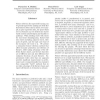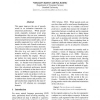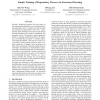80 search results - page 12 / 16 » Simple Features for Chinese Word Sense Disambiguation |
JMLR
2010
13 years 1 months ago
2010
Feature selection for supervised learning can be greatly improved by making use of the fact that features often come in classes. For example, in gene expression data, the genes wh...
NLPRS
2001
Springer
13 years 11 months ago
2001
Springer
We propose a new ensembling method of Support Vector Machines (SVMs) based on Feature Space Restructuring. In the proposed method, the weighted majority voting method is applied f...
ECML
2003
Springer
13 years 12 months ago
2003
Springer
Comparative machine learning experiments have become an important methodology in empirical approaches to natural language processing (i) to investigate which machine learning algor...
ACL
2010
13 years 4 months ago
2010
This paper improves the use of pseudowords as an evaluation framework for selectional preferences. While pseudowords originally evaluated word sense disambiguation, they are now c...
IJCAI
2007
13 years 8 months ago
2007
Recently, significant progress has been made on learning structured predictors via coordinated training algorithms such as conditional random fields and maximum margin Markov ne...



